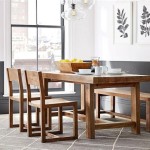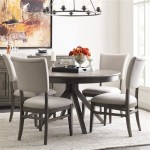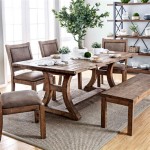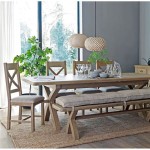Large Antique Dining Room Tables: A Guide to Choosing and Caring
Antique dining tables represent more than just furniture; they serve as a tangible link to the past, embodying craftsmanship and design philosophies of bygone eras. A large antique dining room table, in particular, becomes a focal point, a statement piece that anchors the room and speaks volumes about the homeowner's appreciation for history and artistry. Choosing the right antique table requires careful consideration of various factors, including size, style, wood type, and condition.
Determining the Right Size
The size of an antique dining table is paramount, especially in a dedicated dining room. Accurate measurements of the room are essential to ensure the table fits comfortably, allowing ample space for chairs and movement around the piece. Consider the number of people regularly seated for meals and add extra space for occasional guests. A good rule of thumb is to allow at least 30 inches of space between the table edge and the walls or other furniture. Overly large tables in smaller rooms can feel cramped, while tables that are too small can appear lost in a grand space. Precise measurements of the table's length, width, and height are crucial for determining its suitability for a specific dining room.
Identifying Different Styles and Periods
Antique dining tables encompass a wide range of styles, each reflecting the design aesthetics of their respective periods. Identifying the style of a table can help determine its authenticity and value. Common styles include Victorian, Edwardian, Art Deco, and Georgian, each characterized by distinct features. Victorian tables often feature ornate carvings, intricate details, and darker wood tones. Edwardian tables tend to be slightly less ornate than Victorian, with simpler lines and lighter wood finishes. Art Deco tables embrace geometric shapes and streamlined designs, often incorporating materials like chrome and glass. Georgian tables showcase classic elegance with symmetrical proportions, refined carvings, and mahogany or walnut construction. Understanding these stylistic distinctions is key to selecting a table that complements the overall décor of the dining room and reflects individual preferences.
Evaluating Wood Types and Construction
The type of wood used in the construction of an antique dining table impacts its durability, appearance, and value. Common wood types include mahogany, walnut, oak, and cherry. Mahogany is known for its rich, reddish-brown color and fine grain, prized for its strength and resistance to decay. Walnut, with its warm brown tones and distinctive grain patterns, offers similar durability and a classic aesthetic. Oak, a sturdy and versatile wood, is characterized by its prominent grain and lighter color. Cherry, known for its reddish-brown hue that deepens with age, offers a warm and inviting appearance. Examining the construction techniques used in the table, such as joinery and veneer application, can provide insights into the quality of craftsmanship and the table's overall structural integrity.
Assessing the Condition and Restoration
The condition of an antique dining table is a significant factor affecting its value and usability. Careful inspection for signs of wear and tear, such as scratches, dents, and repairs, is crucial. Checking the stability of the table's legs and the functionality of any extending mechanisms is equally important. While minor imperfections can add to the character of an antique piece, significant damage may require restoration. Understanding the extent of any restoration work and the materials used is essential for making an informed purchasing decision. Consulting with a professional antique furniture restorer can provide valuable insights into the condition of the table and the potential costs associated with any necessary repairs or restoration.
Caring for Your Antique Dining Table
Preserving the beauty and longevity of a large antique dining room table requires proper care and maintenance. Regular dusting with a soft cloth is essential to prevent the buildup of dirt and grime. Avoid using harsh chemicals or abrasive cleaners, which can damage the finish. Protecting the table from excessive moisture and direct sunlight is crucial to prevent warping and discoloration. Using coasters and placemats can help protect the surface from scratches and stains. Periodically waxing the table with a high-quality furniture wax can help maintain its luster and protect the finish. Consulting with a professional furniture conservator can provide guidance on appropriate cleaning and maintenance practices for specific wood types and finishes.
Considering the Value and Investment
Large antique dining tables represent not only functional furniture but also potential investments. Factors like the table's age, rarity, condition, and provenance contribute to its overall value. Researching comparable pieces and consulting with reputable antique dealers can provide insights into the market value of a specific table. While the initial investment in an antique table may be higher than purchasing a new piece, the potential for appreciation over time makes it a worthwhile consideration for collectors and those who appreciate the enduring quality and craftsmanship of antique furniture. Proper care and maintenance can further enhance the value of an antique table, ensuring its preservation for future generations.

Antique Dining Table Do You Want To Go Large With That Regent Antiques

Bespoke 17ft Dining Ref No 09428a Regent Antiques

Large 3m Chestnut Antique Table Dining Farmhouse Sold Gallery

Large Victorian 16 20 Seater Figured Mahogany Dining Table 1850s For At Pamono

Large Antique 6 Legged Table Early 1800s For At Pamono

Antique Dining Table 12ft Victorian Arts Crafts Extending

Vintage 6ft 6 Inch Ref No 09418a Regent Antiques

Log Antique Multi Functional Large Area High Quality Common Dining Table Bedroom Furniture Dning Made In China Com

Large Victorian Dining Table Extending Mahogany Tables 14 Ft 427 Cm

Furniture Of America Dining Tables Cromwell Cm3103t Table Rectangle From Elite








